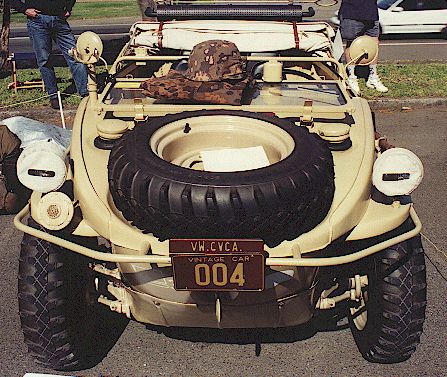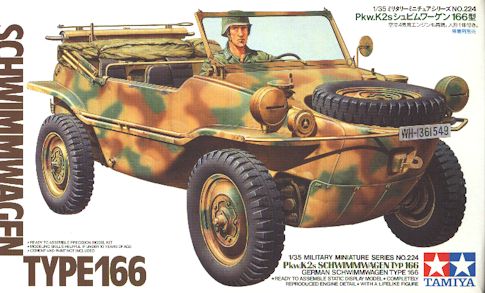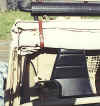|
HyperScale Resource Guide No. 1
Pkw.K2s
Schwimmwagen Typ 166
Photographs by James Blackwell
Reviews, Description and Captions by Brett Green
 |
Restored Schwimmwagen
on Display in Sydney, Australia
|
This is the first in a series of
"HyperScale Resource Guides". The purpose of these guides is to provide a
starting point for research and construction tips on a particular modelling subject. The
first Guide focuses on the Pkw.K2s Schwimmwagen Typ 166. This is a
timely subject given Tamiya's recent release of their new Schwimmwagen kit in 1/35 scale.
In this concise
"HyperScale Resource Guide" you will find a brief background of the vehicle, an
assessment of commonly available kits, a description of the restored subject vehicle
(including areas which are not original), sixteen photos of the restored car and a list of
other sites on the Internet with information and pictures of the Schwimmwagen.
If you only want to look at
one section of the guide such as the review of the new Schwimmwagen, or go direct to the
photos, you may use the subject headings in the "Contents" list below.
Background
Modelling the Schwimmwagen - The Old Kits
Tamiya's New Schwimmwagen - In Box Review
Schwimmwagen Walkaround - Description of Vehicle
Exterior Photographs
Interior Photographs
More Schwimmwagens on the Web
The Typ. 166 Schwimmwagen was the definitive version of this amphibious German military
car. It was originally based on the basic chassis and drivetrain of the standard
Volkswagen Beetle. The powerplant was a Volkswagen 1,130 cc, air cooled four cylinder
petrol engine which would still look familiar to VW owners today. This "flat
four" motor was rear mounted and drove the rear wheels. Four wheel drive was
selectable via a stick-shift. 25 horsepower was available to propel the little amphibious
car up to 80 kph on land, and up to 10 kph in the water.
The propeller assembly was lowered into the water
when running in amphibious mode, and was directly connected to the engine crankshaft to
provide efficient power transfer.
Mass scale production of the Type 166
Schwimmwagen commenced in 1942 following earlier trial developments of the amphibious
Volkswagen. 14,276 were produced when production ended in late 1944.
The Schwimmwagen was used widely by Wehrmacht and
SS units on the Eastern and Western fronts. It was mainly operated in reconnaissance and
liaison roles where its amphibious versatility and rough-ground capability gave it an edge
over virtually all other vehicles.
The Schwimmwagen was a highly successful and
sought-after development of the Volkswagen family of vehicles.
| M o d e l l i n g t h e S c h w i
m m w a g e n - T h e O l d K i t s |
Schwimmwagen kits have been released by a number of
kit manufacturers over the years. Despite the selection of kits, they all suffer from
inaccuracy and incomplete detail. A complete list of Schwimmwagen kits in all scales can
be found in the IPMS Houston
Schwimmwagen article, but some of the more common offerings are briefly described
below:
1/35 Scale Tamiya Kit MM-3 (or
MM-3503 depending on your boxing).
This kit dates from 1970 and
looks like it! The shape is wrong, it is woefully oversimplified and the only good news is
the inclusion of the wide wheels and tyres. The bad news is that the wheels are completely
wrong, failing to capture the "dished" look of the original, and the tread
pattern is fatally oversimplified. Give this kit to a ten year old nephew!
1/35 Scale Italeri Kit No. 313.
A better offering than Tamiya but still
oversimplified with no belly detail. All mesh grilles are moulded solid. There are also
some obvious inaccuracies, which include the portrayal of a bench seat in the rear. See
photos below for the correct configuration of two separate seats.
1/48 Scale Frog/Fuman/Bandai.
A simple little kit, yet offering
engine, transmission and basic suspension detail. Accuracy is suspect in some areas
including the seats. Other details (such as the buckles and the folding mechanism for the
canvas tilt) are massively over-scale in 1/48. Even so, less embarrassing than the old
Tamiya kit.
But now Tamiya redeems itself by introducing a brand new gem in 1/35.
| T a m i y a ' s N e w S c h w i m
m w a g e n I n B o x R e v i e w |
The first piece of good news is that Tamiya's 1/35
scale kit MM-224 shares nothing in common with their original Schwimmwagen from
1970.
 The second item of good news is that this
new Schwimmwagen is state-of-the-art Tamiya. The kit is cleverly designed, simple in parts
breakdown, accurate and well detailed. The second item of good news is that this
new Schwimmwagen is state-of-the-art Tamiya. The kit is cleverly designed, simple in parts
breakdown, accurate and well detailed.
The bad news is... well, there is
not much bad news!
What's In the Box
Tamiya's new Schwimmwagen
consists of 90 parts on two separately bagged sprues of tan coloured styrene, one clear
acetate sheet and one 6cm x 6cm sheet of vinyl mesh. A casual Wehrmacht driver figure is
included. His tunic is unbuttoned with the sleeves rolled up, and his pose is very
relaxed.
Kit features include engine
detail, positionable engine cover, movable propeller mount, a delicate lowering rod,
canvas top in folded position, narrow wheels and authentically reproduced vinyl mesh
bulkhead at the rear of the passenger cabin. Vinyl mesh is also used to represent the
ventilation grilles on top of the engine compartment.
What's Not In the
Box
There is no kit option for the
commonly seen wide tyres, nor for the hood in deployed position. Weapons are not supplied.
Kit Detail
Detail is everything that one
expects from a new Tamiya kit. Both under-dash fuel tanks are present. The timber floor
slats are subtly textured in a woodgrain finish although, curiously, this texture is not
carried through to the angled footrests. The four individual leather seats are creased in
a subdued and realistic fashion. The lower body includes moulded-on drain tubes which are
hollowed out at the ends. The propeller is attached to its circular guard in a single
moulding, and looks very good. The lifting handle for the engine hatch (part B42) is one
of the finest detail parts I have seen in injection plastic (with the exception of Model
Kasten's amazing Stug. IIIG Detail Set).
Visible engine detail has been
designed with the minimum number of parts but with no compromise in detail. The cylinders
and block of the flat-four engine are moulded as part of the engine bay, and the more
visible fan assembly, fan belt, carburetor and general plumbing are separate parts. This
should build into a convincing little replica yet the entire assembly, including engine
bay and the forward bulkhead, comprises of only six parts.
Decals are provided for three
Wehrmacht vehicles. Another nice touch is that decals are also supplied for a couple of
placards in the engine bay and on the dashboard.
Suggested Improvements
The only areas needing
improvement are the oversimplified machine gun mount on the front passenger side (part
B1), the tool clamps, the rear of the taillight mounting bracket and the rear locking
clamps for the engine cover. The determined detailer may also wish to add a few tiny
missing details. These include wing nuts for the ends of the windscreen hinge, little
tie-downs on the inside of the windscreen frame, canvas-tilt attachment points on the top
of the windscreen, a loop for the lowering rod on the propeller assembly and stowage
straps along the inside upper wall of the cabin. Finally, no restraint is provided for the
stowed propeller assembly, so a strap and mount should be added. However, the kit
will look superb even without these extra details.
The engine vents will benefit
from some slight modification. If the instructions are strictly followed, the mesh grilles
will be recessed too far below the vent openings due to the thickness of the plastic. The
upper body should be reduced to scale thickness around the vent openings before attaching
the mesh to achieve a more realistic appearance. An alternative is to cut the mesh to the
exact shape of the vent and fix it on the top inside edges of the vents.
Construction Tips
The suspension assembly shares a
number of parts in common with Tamiya's recent Kubelwagen kit. Take care when fixing the
wheels to the suspension arms. The original vehicle had a reputation for weak suspension,
and Tamiya's careful duplication means that the link between the suspension arms and the
wheels is quite delicate. I recommend using Cyano glue (Super Glue) to get a quick, strong
bond between the suspension arms and the wheels. I will probably also use Super Glue to
fix the rear suspension trailing arms (parts B46 and B47) to the lower body.
Care will also be required when
separating the acetate windscreen from its surrounding sheet. As with the Kubelwagen kit,
the acetate windscreen is commendable for its scale-thickness and clarity. Unlike the
Kubelwagen, Tamiya have recessed the join so that the windscreen has one "tab"
on each edge. This has eliminated the problem of stress marks that were present on the
edges of the Kubelwagen windscreen. The instructions recommend using scissors to cut these
tabs, but I will be using a brand new knife blade to avoid creasing or otherwise damaging
the flexible acetate.
Conclusion
This little kit is another
masterpiece by Tamiya. It will build into a lovely model right out of the box, and is by
far the best Schwimmwagen model offered in any scale. It would have been nice to get the
option of wide tyres, but the eager after-market resin industry will certainly
address that minor shortcoming soon. With a small amount of extra effort a perfect
Schwimmwagen replica is now within the reach of most modellers.
Highly Recommended.
| S c h w i m m w a g e n W a l k a r o u
n d P h o t o g r a p h s |
This Schwimmwagen was photographed
during September 1996 at a Volkswagen Car Club meeting in Dural on the outskirts of
Sydney. As far as can be determined this is the only original Schwimmwagen in
running condition in Australia.
The vehicle is in remarkable
shape, and the owner has obviously gone to a great deal of trouble to authentically
restore the vehicle. There are, however, some non-standard modifications. These include:
- The muffler, its perforated cover
and the reinforced pipes and brackets are replacements for the original, flimsy
Schwimmwagen parts. This was necessary as the original parts would have almost rusted to a
state of dust after 50 years.
- Shock Absorber Struts were added
to the rear to bolster the weak rear suspension arms.
- Flanges are welded to the front
suspension arms to accommodate shock absorber struts, although the struts are not in
place.
- The red filler cap on the bonnet
and possibly the red handle on the dash are non-standard
- The starboard side tail-light is
probably a concession to Australian motor registration requirements.
- The canvas roof is also probably a
replacement.
The vehicle wears genuine
Continental tyres with the appropriate tread. The paddle is also original, having been
obtained at an auction in France.
The overall impression of the
vehicle is that it is very complete and authentic.
Exterior
Photographs
Click on the
thumbnails below to see the full sized image. To return to this page click the
"Back" arrow on your browser.
 The nose of the
Schwimmwagen. Note the weld bead where the tub side meets the centre section. It is also
interesting to note the dimpling of the thin sheet metal where the front apron meets the
main body of the vehicle at the front. Dimples are also visible at each spot-weld where
the front fender is attached to the body. The nose of the
Schwimmwagen. Note the weld bead where the tub side meets the centre section. It is also
interesting to note the dimpling of the thin sheet metal where the front apron meets the
main body of the vehicle at the front. Dimples are also visible at each spot-weld where
the front fender is attached to the body.
 Note where the shovel mount is welded
to the side of the body. The wing nut and other windscreen details are visible in this
photograph Note where the shovel mount is welded
to the side of the body. The wing nut and other windscreen details are visible in this
photograph
 The spare tyre secured with three
bolts. Note the black tyre valve. This vehicle is equipped with the wider wheels and
tyres. The wheels are quite deeply dished. The spare tyre secured with three
bolts. Note the black tyre valve. This vehicle is equipped with the wider wheels and
tyres. The wheels are quite deeply dished.
 Top view of filler and windscreen
details. Note the tie downs at the inside base of the windscreen and the canvas-tilt
attachment points at the top of the windscreen. Top view of filler and windscreen
details. Note the tie downs at the inside base of the windscreen and the canvas-tilt
attachment points at the top of the windscreen.
 Front three-quarter general view. Front three-quarter general view.
 Good detail shot of the paddle, the
clamp for the paddle handle and the drain tube. Good detail shot of the paddle, the
clamp for the paddle handle and the drain tube.
 General rear-three-quarter view
featuring the propeller assembly. Note the clamps for securing the engine cover. The loop
for the lowering rod can be seen on the top cover of the propeller assembly in this view General rear-three-quarter view
featuring the propeller assembly. Note the clamps for securing the engine cover. The loop
for the lowering rod can be seen on the top cover of the propeller assembly in this view
 Rear view. The extra tail-light
is probably required for roadworthiness in Australia. Rear view. The extra tail-light
is probably required for roadworthiness in Australia.
 Note the leather retaining strap for
the stowed propeller assembly. Note the leather retaining strap for
the stowed propeller assembly.
 General starboard side view. General starboard side view.
 Great detail shot of the starboard
headlight and its mount with the canvas cover, the horn and the forward machine-gun
mount. Great detail shot of the starboard
headlight and its mount with the canvas cover, the horn and the forward machine-gun
mount.
Interior
Photographs
 General dashboard
layout. Note wooden planks and footrests. General dashboard
layout. Note wooden planks and footrests.
 Good under-dash detail of fuel tanks. Good under-dash detail of fuel tanks.
 Nice shot of the stowed canvas hood,
the retaining straps and a small chain. The black seats are quite glossy. Note the
non-standard perforated exhaust guard. The square metal object bolted to the bar behind
the front seats is a rack for two rifles. The function of the small chain dangling against
the rear bulkhead is not known. It is too short to be a restraint for the canvas tilt and
appears too flimsy to hold the propeller assembly. Nice shot of the stowed canvas hood,
the retaining straps and a small chain. The black seats are quite glossy. Note the
non-standard perforated exhaust guard. The square metal object bolted to the bar behind
the front seats is a rack for two rifles. The function of the small chain dangling against
the rear bulkhead is not known. It is too short to be a restraint for the canvas tilt and
appears too flimsy to hold the propeller assembly.
 Good general view of the interior. The
painted mesh at the rear of the cab is well displayed here. Good general view of the interior. The
painted mesh at the rear of the cab is well displayed here.
| M o r e S c h w i m m w a g e n s
o n t h e W e b |
There are at least two other sites with Schwimmwagen"walkaround" photos.
IPMS Houston - Schwimmwagen
Walkaround
The first is at IPMS Houston's website. This excellent article gives an interesting
history of the vehicle, a list of Schwimmwagen references and has 20 well captioned
photographs. The shots have been taken on a cloudy day providing high quality photographs
showing good detail. When you have finished looking at the Schwimmwagen article, check out
the rest of the site. Well worth a look. You can find this site by following this link:
http://web-hou.iapc.net/~smh/Schwimm.html
Rob Plas - Schwimmwagen
Special
Rob's Dutch site also has a "walkaround" style photo-feature on the
Schwimmwagen. Be warned, however - the thumbnails take a long time to load because they
are the same bandwidth as the full sized images! URL is as follows:
http://people.zeelandnet.nl/robplas/specials.htm
Photographs and Source Information Copyright 1998 by James Blackwell
Descriptions, Reviews and Captions Copyright 1998 by Brett Green
Also visit Track-Link for the
best in armour modelling
Page Created 21 April, 1998
Last updated 09 May, 2002
Back to References
Back to HyperScale Home Page
|
Home |
What's New |
Features |
Gallery |
Reviews |
Reference |
Forum |
Search